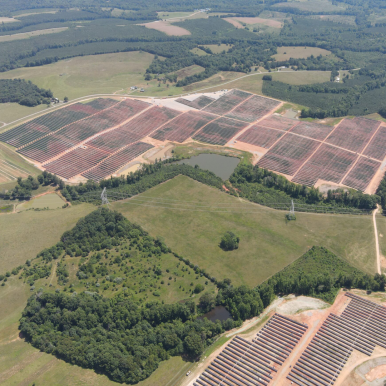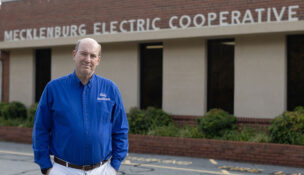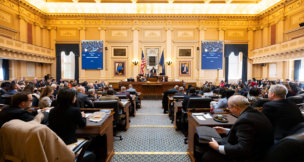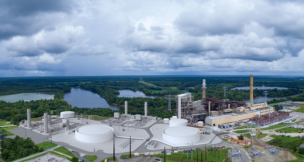Power plays
Grid upgrades, renewable energy on horizon
Virginia’s largest electric utilities are deploying an array of technologies as they decarbonize, digitalize and decentralize their power grids to meet the state’s and their own clean energy goals.
Richmond-based Dominion Energy Inc. and Charleston, West Virginia-headquartered Appalachian Power are expanding their solar, wind and battery storage portfolios while advancing a massive power grid transformation. Both utilities have companywide goals of achieving net-zero greenhouse gas emissions by 2050.
Those objectives took on more urgency after former Gov. Ralph Northam signed the Virginia Clean Economy Act (VCEA) in 2020. The landmark Democratic-led legislation includes a strict mandate that all electricity consumed in the state must have zero carbon emissions and be generated from renewable sources by 2045 for Dominion, which serves 2.5 million Virginia customers, and 2050 for Appalachian Power, which has about 524,000 customers in the commonwealth, stretching from Southwest Virginia to the New River and Roanoke valleys to southern Albemarle County.
Although Republicans wield more power in Richmond this year and have expressed dissatisfaction with the VCEA, utilities do not expect significant changes to the policy.
“We’re optimistic that we will see the VCEA stay as it is,” says Chris Beam, president and chief operating officer of Appalachian Power. “It’s a good piece of legislation that moves the state forward.”
Dominion officials also are watching closely as new Republican Gov. Glenn Youngkin advances his agenda. “We look forward to and stand ready to work on a collaborative basis with Gov. Youngkin and the General Assembly,” says Katharine Bond, the Fortune 500 utility’s vice president of public policy, state and local affairs. “Reliability and affordability are important to people of both parties, and our customers and other key stakeholders urge us to continue focusing on those tenets as we transition to clean energy.”
Most prominently, Dominion has significantly expanded its offshore wind and solar portfolio. The utility’s largest project to date — the $9.8 billion, 2.6-gigawatt Coastal Virginia Offshore Wind Project off the coast of Virginia Beach — will provide clean, renewable energy to 660,000 homes when it’s completed in 2026. Dominion’s solar output has increased from 1 megawatt of solar power in 2015 to more than 5,240 megawatts now available or under development.

Strengthening the grid
Along with adhering to the VCEA, utilities must also ensure that customers’ lights stay on, costs remain low, and grid security is maintained. “The key to grid transformation is ensuring safety, reliability and affordability,” says Joe Woomer, Dominion’s vice president of grid and technical solutions. “Those things are all connected.”
Dominion has invested in renewables and grid transformation while keeping customer rates lower than the national average, notes Mike Doyle, an Edward Jones senior equity analyst specializing in utilities. “That gives them potentially more opportunities and wiggle room to make investments.”
In 2018, Dominion launched its 10-year grid transformation plan. Slated to run from 2019 to 2028, the initiative aims to boost grid reliability and security, while replacing its aging customer information system with a new platform to provide consumers more power usage information. It will also pave the way for the utility to integrate more renewable energy sources into the grid while maintaining service standards.
“Part of our mission is to make sure our grid is reliable,” Woomer says. “That’s why we need digitalization of our distribution system so we can see what’s happening at all times and respond to that.”
In January, the State Corporation Commission gave Dominion the green light to embark on Phase 2 of the utility’s 10-year plan. Totaling more than $650 million, the second phase, which runs through 2023, will focus on smart meters and grid devices that offer real-time data to optimize the assimilation of distributed energy resources, including solar, wind, battery storage and electric vehicles.
Phase 2 includes the deployment of smart meters, which the SCC had previously rejected due to concerns over potential customer rate increases. The smart meters will allow Dominion to offer new programs, such as a voluntary time-of-use rate, which encourages customers to shift their energy usage to off-peak hours.
“It takes the energy grid from something designed decades ago to harness technological improvements for the benefit of our customers,” notes Bond. “Not only will the grid be able to tell us if there’s an issue and where the issue is, we will also ready the grid for transferring power from large centralized power plants to multiple plants.”
Dominion is investing $198.3 million to replace approximately 1.1 million electric meters with smart meters that will allow customers to track and adjust their energy usage based on timely data, with deployment to be completed by 2024.
“Smart meters will help modernize our grid and improve the customer experience with enhanced two-way communication, as well as increase operational efficiencies,” Woomer says. “There will be an end-of-line sensor in every home that will tell us usage and voltage. We will be able to see in advance problems that may arise and respond to problems quicker.”
But the Southern Environmental Law Center says Dominion’s grid transformation plan is not cost effective.
“We don’t believe the majority of those investments are worthwhile,” says Will Cleveland, a senior attorney with the Charlottesville nonprofit. “They do not necessarily accelerate or improve the transfer of renewable energy onto the grid.” For example, Cleveland says, Dominion opted to purchase software to monitor distributed resources, as opposed to paying a lower licensing fee for the program. “We want to make sure every dollar is spent to maximum value to the customer.”
With more renewables coming online, multiple smaller generation facilities, such as those for solar power, will allow two-way directional energy flow as opposed to a large central power plant. “The modern grid will be able to accept and, in some cases, store energy from solar and wind, which are intermittent,” Dominion’s Bond says. “It will be able to know when another resource needs to be ratcheted up or down to ensure [the] flow of reliable sources of energy to customers 24 hours a day, seven days a week, 365 days a year.”
Dominion also is expanding its energy storage capacity to reach the VCEA-mandated 2,700 megawatts of storage by 2035. The utility’s 20-megawatt Dry Bridge Energy Storage facility in Chesterfield County is slated to open this year, and another project with 50 megawatts of storage is on tap in Loudoun County. Four battery pilot projects in Central Virginia also will provide data on how to incorporate batteries on Dominion’s grid.
Net-zero goals
Meanwhile, Dominion recently announced a goal to achieve net-zero emissions outside its direct operations, including those generated downstream by customers and upstream by suppliers.
Appalachian Power has charted a similar path to reach net-zero carbon emissions. “It’s great to have a goal,” Beam says. “The meat and potatoes is, how do you do that?”
Appalachian Power plans to have about 3,300 megawatts of solar power, 3,000 megawatts of offshore wind power and 2,600 megawatts of energy storage in Virginia by 2040. “We will be net zero by 2050,” Beam asserts. “Right now, there is no technology that has net-zero carbon emissions, but we will offset emissions through other things.”
Last fall, Appalachian added 20 megawatts of solar power through a power purchase agreement with a solar generation facility in Henry County, and the utility will add 35 megawatts of contracted solar power in Campbell and Wythe counties this year. In January, Appalachian announced plans to acquire or contract for 294 megawatts of solar and 204 megawatts of wind power over the next three years, Beam says.
Modernizing the power grid is another top priority. “The grid has to be designed differently and work differently in the future,” Beam says. “Originally, large central power stations generated power transmitted through power lines to users as one-way flow. With more renewables and distributive generation assets, the grid needs to have two-way flow.”
Like Dominion, Appalachian is providing smart meters for its Virginia customers. “It’s an integrated network that allows us to know about an outage at a specific household and lets us have a more accurate map of how big the outage is so we can respond faster,” Beam explains.
Smart circuits also are vital to modernization. “These circuits can detect an outage and look at the configuration of the entire system and shrink the outage to as small as possible,” Beam says. “The dispatch center is notified that the outage has been shrunk and where to dispatch crews to solve the problem. If we can reduce it, it’s a better experience for our customers and employees.”
State regulators in 2020 approved Appalachian Power’s pilot project to install fiber optic cable on its utility poles in Grayson County to support deployment of smart meters and technology to pinpoint problems on the circuits. As a bonus, internet service providers can lease the fiber and offer broadband service to residents in rural areas underserved by high-speed internet.
Appalachian Power also is encouraging customers to switch to electric vehicles. “We see that as the next game changer from a big emitter of carbon in the transportation sector,” Beam says.

Different kinds of green
Youngkin was willing to fine-tune the VCEA, but he seeks to end Virginia’s participation in the Regional Greenhouse Gas Initiative, an 11-state coalition working to tackle climate change by reducing greenhouse gas emissions in the power industry. In a December 2021 speech to the Hampton Roads Chamber of Commerce, he described RGGI as a “carbon tax that is fully passed on to ratepayers.”
So far, his efforts have failed, with the Democratic-controlled state Senate Committee on Agriculture, Conservation and Natural Resources voting to stop a bill that would have amended the Clean Energy and Community Flood Preparedness Act that authorized the state’s participation in RGGI beginning last year.
The Southern Environmental Law Center disagrees with Youngkin’s position on RGGI. “Virginia’s participation has brought in hundreds of millions of dollars directly used to fund recurrent flooding adaptation measures across the state and fund energy efficient programs, particularly for low-income customers,” Cleveland says.
Bond says, though, that a central component of RGGI does result in higher costs for customers. “Virginia’s clean energy goals require an investment,” she says. “When you layer RGGI onto that, there’s unintended consequences in terms of increased costs and higher emissions. There may be more effective ways to lower carbon in the future than the way RGGI was designed.”
Finding those answers, while modernizing the power grid and meeting state and national environmental goals, requires both technology and talent, says Jim Thomson, vice chair and U.S. power, utilities and renewables leader at Deloitte.
“People want to know the company they work for is a green organization,” he says. “Traditionally, that hasn’t been utility companies, but now they are proactively working to make sure talent understands that utilities are one of the greener industries focused on the planet right now.”
A greener industry that still prioritizes keeping the lights on and rates affordable, Beam notes. “That’s the challenge. We can transform to carbon free, but we have to make sure we’re still affordable and don’t sacrifice reliability. Those are things we have to figure out between now and 2050.”
Editor’s note: This story has been corrected from the version originally published. Phase 2 of Dominion Energy’s 10-year plan was approved by the State Corporation Commission following its first filing. Additionally, smart meters discussed in the story provide timely data for customers to track and adjust their energy usage, but not real-time data.
-














